Originally published June 16, 2010 by CityArts
Viewing the photographs of Renato D’Agostin is like stepping backwards in photographic history. In fact, I was convinced that it was a show of vintage prints, until the gallery told me that is a completely contemporary show.

Renato D'Agostin- Tokyo
It is a show of works about Tokyo, capturing those fleeting moments of observation and composition that were a benchmark of photography in the 1970s. Partial views of the body, architecture and the all-defining role of light combine to make these prints exquisite jewels.
The silver prints glow like photographs used to glow. The photographs are composed and printed with a care and craft that we see all too rarely these days. Each one, hand printed, helps you remember the luscious tones that “old school” photography conveys. It was not a surprise to discover that D’Agostin is a protégé of Ralph Gibson, whose influence is obvious in the younger man’s work. The presence of the mentor, however, is in no way a bad thing. It used to be that young photographers would work for a master, absorb their influence and then set off on their own. D’Agostin has done this, and while there is homage to the master, he has forged ahead with an entirely personal vision.
Describing these photos is challenging because they are at once deceptively simple and complex. “Number 8,” for example is a fuzzy partial view of a man’s head in profile, a stretch of empty white and then a bird flying out of the picture frame. The image captures a simultaneous sense of motion and stillness. The man and the bird are each dynamic, moving in opposite directions out of the picture frame, and yet each is caught in a moment of elegant, eloquent stillness.
This is a very special exhibition for anyone interested in photography. Contemporary, yet reminiscent of the past. Perhaps the proper word is timeless.
Through July 3, Randall Scott Gallery, 111 Front St., Ste. 204, Brooklyn, 212-796-2190.
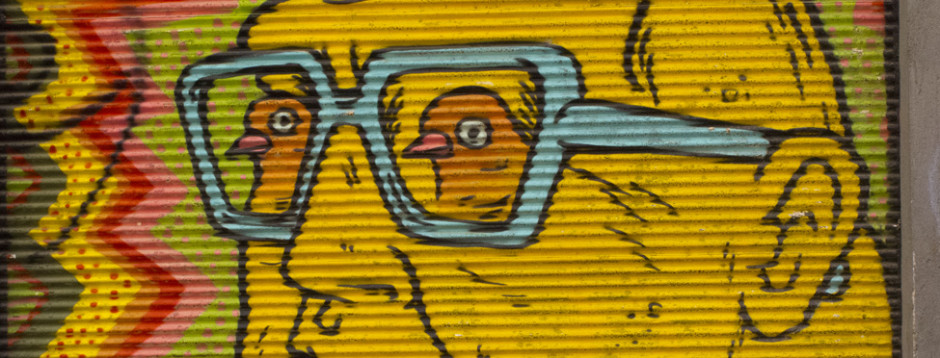
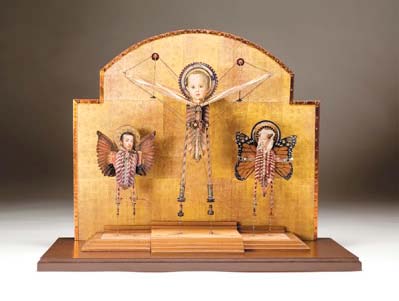 Viewing the deliciously obsessive art of David Barnett, one is drawn into his world of twisted Victoriana and mechanical madness. The exhibition at Denise Bibro Gallery is a combination of collage, found objects and extraordinary mechanisms fabricated by the artist. It is a complex show, and not everything works, but the pieces that do are knockouts.
Viewing the deliciously obsessive art of David Barnett, one is drawn into his world of twisted Victoriana and mechanical madness. The exhibition at Denise Bibro Gallery is a combination of collage, found objects and extraordinary mechanisms fabricated by the artist. It is a complex show, and not everything works, but the pieces that do are knockouts.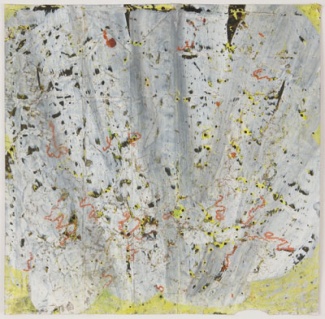 What goes on in the mind of a children’s book illustrator. Rainbows and ponies and the sweetness of childhood? The exhibition of drawings by Douglas Florian (at
What goes on in the mind of a children’s book illustrator. Rainbows and ponies and the sweetness of childhood? The exhibition of drawings by Douglas Florian (at 
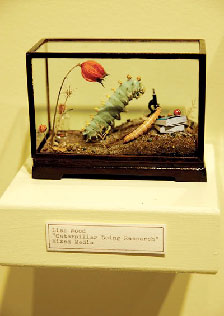 In the spirit of full disclosure, I admit that I love insects. Give me a Madagascar Hissing Cockroach, a dung beetle or a giant furry bumblebee, and I’m a happy camper. So it was with some bias that I journeyed to the edge of the Gowanus Canal last week to see Entomologia, an exhibition of artists who work with bugs and bug imagery. The exhibit is housed in a year-old exhibition space called The Observatory. Founded by a group of seven artists, The Observatory seeks to investigate “topics residing at the interstices of art and science, history and curiosity, magic and nature.” This exhibition fulfills their mission to perfection.
In the spirit of full disclosure, I admit that I love insects. Give me a Madagascar Hissing Cockroach, a dung beetle or a giant furry bumblebee, and I’m a happy camper. So it was with some bias that I journeyed to the edge of the Gowanus Canal last week to see Entomologia, an exhibition of artists who work with bugs and bug imagery. The exhibit is housed in a year-old exhibition space called The Observatory. Founded by a group of seven artists, The Observatory seeks to investigate “topics residing at the interstices of art and science, history and curiosity, magic and nature.” This exhibition fulfills their mission to perfection.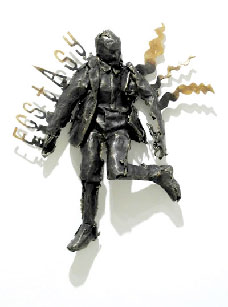 Lesley Dills’ new work, in paper and bronze, is literally full of the language and imagery of transcendence. Drawing on the words of several writers, but most notably Emily Dickinson, she has created a world in the process of “becoming.” Pieces titled “Rapture,” “Ecstasy” and “Joy” convey the excitement, passion and terror of a creative existence. The exhibition is simply thrilling.
Lesley Dills’ new work, in paper and bronze, is literally full of the language and imagery of transcendence. Drawing on the words of several writers, but most notably Emily Dickinson, she has created a world in the process of “becoming.” Pieces titled “Rapture,” “Ecstasy” and “Joy” convey the excitement, passion and terror of a creative existence. The exhibition is simply thrilling.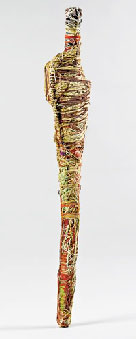 Traditionally, much of outsider art has been figurative. That’s in large part due to outsider art’s appeal to mainstream viewers: The work is a kind of skewed vision of the world as we know it. Like a funhouse mirror, the work of outsider artists portrays a world tweaked by the filters of madness, illiteracy, loneliness or any number of factors that renders someone “outside” of society.
Traditionally, much of outsider art has been figurative. That’s in large part due to outsider art’s appeal to mainstream viewers: The work is a kind of skewed vision of the world as we know it. Like a funhouse mirror, the work of outsider artists portrays a world tweaked by the filters of madness, illiteracy, loneliness or any number of factors that renders someone “outside” of society.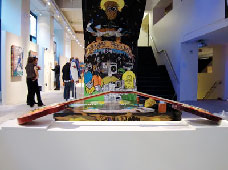 If you’re strolling past the corner of East Fourth Street and Broadway, site of the old Tower Records store, you’re likely to hear an unlikely sound coming from the building: music. Through Feb. 13, a scrappy and wonderful new not-for-profit group called No Longer Empty has commandeered the building and filled it with site-specific artwork—part of a show called Never Can Say Goodbye—that is all informed by that wonderful old-media phenomenon, the record store.
If you’re strolling past the corner of East Fourth Street and Broadway, site of the old Tower Records store, you’re likely to hear an unlikely sound coming from the building: music. Through Feb. 13, a scrappy and wonderful new not-for-profit group called No Longer Empty has commandeered the building and filled it with site-specific artwork—part of a show called Never Can Say Goodbye—that is all informed by that wonderful old-media phenomenon, the record store.